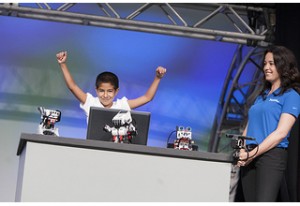In a former life, as a fresh college graduate, I accepted a job as business reporter on a daily newspaper. I remember being so nervous, wondering how I would be able to write about something I really knew nothing about. And then I started the job and fell in love with it. I felt the same way when I started working as a technical editor, and the same thing happened—I fell in love with the work, and was once again covering businesses and the technologies and products they design and manufacture.

One area that I’ve also fallen in love with over the years is the importance of STEM education. I love covering stories about kids and science and engineering, from middle school events like the Fluid Power Challenge, to high school events like the FIRST Robotics Competition, and even college competitions like Parker Hannifin’s Chainless Challenge.
So I was delighted yesterday morning at the final keynote presentation of NIWeek, where the company highlighted its endeavors with education. Presenters included Pernille France, Senior Director of Lego Education, who helped introduce NI’s newest Lego Mindstorm’s EV3 platform. They even had a student, David Bocanegra, demonstrate how easy it is to use the software to build a Lego Mindstorm robot, program it to move, sense objects, and react to those objects.
Next, NI introduced FIRST Robotics Team 2468 from Westlake High School, who talked about their experience building a FIRST Robot, and how it impacted their lives, giving them more confidence, allowing them to mentor elementary students, even a team in Nigeria, and build a successful design. NI also announced it will be donating one of its new controllers to every team, which has been designed specifically for FIRST student designs.
“When we set out to create a new controller for high school robotics, we wanted to lower the barrier for rookie teams while at the same time providing the capabilities that will empower innovation for years to come,” said Chris Rake, Senior Group for RIO Embedded Hardware. “In order to do this, we started with the LabVIEW RIO architecture and used the same Xilinx Zync ARM Cortex-A9 dual-core processor and FPGA that’s used in CompactRIO. This represents a 500 percent increase in performance over today’s control system.”
The above YouTube video is of students in the FIRST Robotics exhibit hall booth at the event.
The keynotes wrapped up with two awesome presentations about space exploration from Leland Melvin, Associate Administrator for Education, NASA and Dr. William “Red” Whittaker, Professor, Carnegie Mellon University and CEO and CSO, Astrobotic Technology.
In addition to this, the convention center was full of families with young children who had a chance to explore NI’s technology hands-on. I have to hand it to the company’s marketing folks. What better way to ensure your company’s future than give the technology to the engineers and scientists of the future now, and make them believers in the simplicity and ease of use of the hardware, software and embedded programs now. They’ll be pros at LabView, CompactRIO and whatever next generation of technology when they graduate university.
